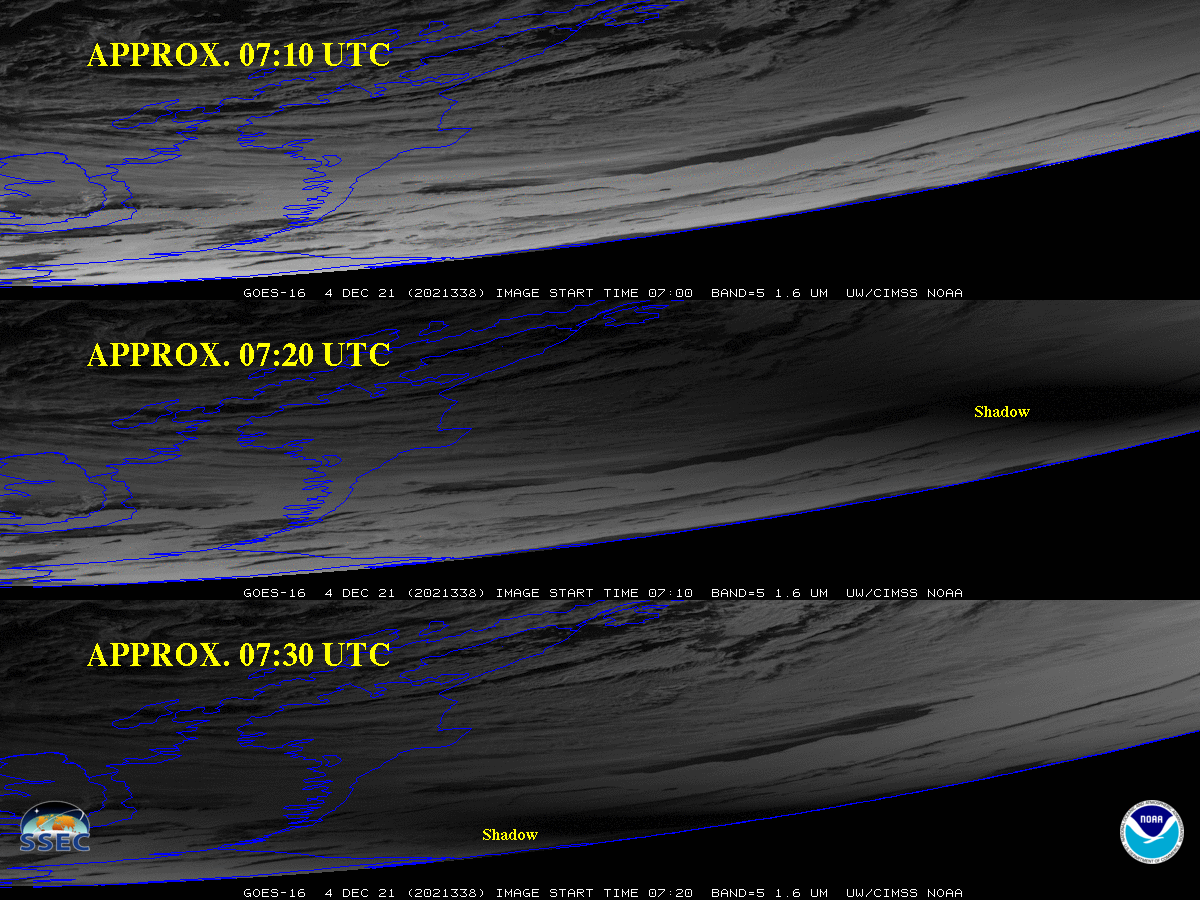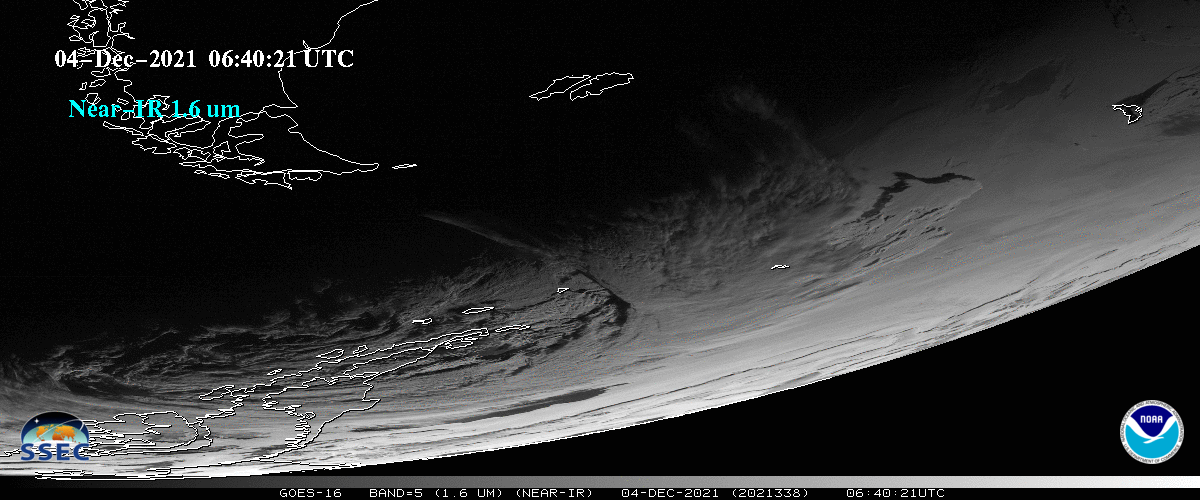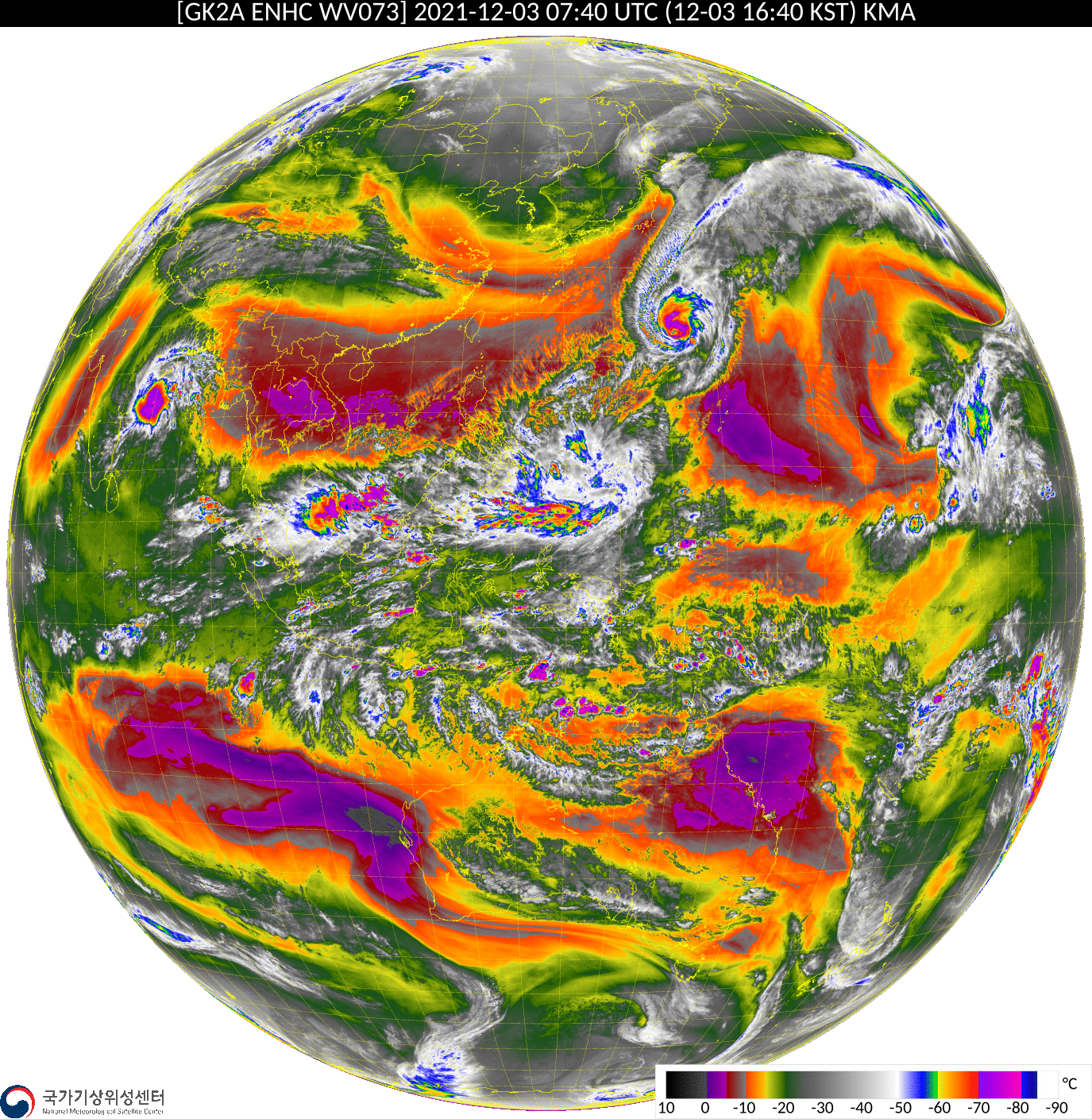
[ Archive ]

 |
CIMSS-NOAA Weekly Report [ Archive ] |
 |
CIMSS AND ASPB WEEKLY HIGHLIGHTS FOR THE WEEK ENDING DECEMBER 10, 2021
PRODUCTS AND APPLICATIONS:
Eclipse Shadow Images shown to the Calibration Working Group: GOES-R Advanced Baseline Imager (ABI) images during the recent total solar eclipse on December 4, 2021 were presented at the weekly GOES-R series Calibration Working Group (CWG) meeting. The moon's shadow was seen as it passed over Antarctica in several geostationary and polar-orbiting images. More on this case: https://cimss.ssec.wisc.edu/satellite-blog/archives/43656, including comparisons between different spectral bands: https://cimss.ssec.wisc.edu/satellite-blog/images/2021/12/SHADOW5_B2_5_2021338_070021_GOES-16.gif. (T. Schmit, E/RA2, 608-263-0291)
 (Click image to enlarge)
(Click image to enlarge)
Figure: GOES-16 ABI Band 5 (1.6 um) showing the moon's shadow cast near Antarctica during a solar eclipse on December 4th, 2021. Three times are shown.
AWARDS AND RECOGNITION:
PUBLICATIONS:
WORKSHOPS, CONFERENCES, AND MEETINGS:
CIMSS Team Helps Lead International Tropical Cyclone Workshop: Members of theCooperative Institute for Meteorological Satellite Studies (CIMSS) Tropical Cyclone (TC) group helped lead the third World Meteorological Organization (WMO) International Workshop on Satellite Analysis of Tropical Cyclones (IWSATC-3) December 7-10, 2021. The virtual format permitted a much larger attendance than the previous two workshops that were held in 2011 and 2016. More than 300 attendees were signed up with participation exceeding 170 on each day. The previous workshop in 2016 had only 35 attendees. Derrick Herndon co-chaired with Joe Courtney from the Bureau of Meteorology Australia and Anne-Claire Fontan from WMO. IWSATC provides an opportunity for the research and operational community to discuss priorities and share the latest advancements in tropical cyclone monitoring, analysis and display systems. The CIMSS TC team presented and led discussions on the latest algorithm developments by the group. The workshop provided the first exposure for some attendees to artificial intelligence (AI) techniques for tropical cyclone analysis and forecasting, with CIMSS presenting an AI version of the Advanced Dvorak Technique (AiDT) and an AI product developed by Sarah Griffin for TC rapid intensification guidance. Tony Wimmers presented a talk on satellite deep learning tools for TC intensity analysis and assisted with leading breakout discussions. The workshop completed on Thursday night December 10th with three case studies of storms that attendees analyzed using tools presented earlier in the week. More information is available at https://community.wmo.int/meetings/third-international-workshop-satellite-analysis-tropical-cyclones-iwsatc-3. (D. Herndon, CIMSS, 608-262-6741)
 (Click image to enlarge)
(Click image to enlarge)
Figure: Attendees from 43 countries attend the WMO International Workshop on Satellite Analysis of Tropical Cyclones (IWSATC-3) December 7-10, 2021.
CIMSS participates in JPSS Arctic Initiative kickoff meeting: Tom Greenwald (Cooperative Institute for Meteorological Satellite Studies, CIMSS), Yinghui Liu (NOAA), Kathy Strabala (CIMSS), Aaron Letterly (CIMSS), Liam Gumley (CIMSS) and Jeff Key (NOAA) participated in the Joint Polar Satellite System (JPSS) Arctic Initiative kickoff meeting on December 1, 2021. The purpose of the initiative is to increase the use of JPSS atmospheric and cryosphere products to improve NOAA's products and services in the Arctic. Greenwald presented a NOAA-funded JPSS project to support users at the National Weather Service Alaska Sea Ice Program (ASIP) and US National Ice Center (NIC) by providing spatially enhanced operational sea ice products from the Advanced Microwave Scanning Radiometer-2 (AMSR2), including imagery, sea ice concentration and sea ice thickness. (T. Greenwald, CIMSS, 608-263-3629)
TRAINING AND EDUCATION:
JPSS Virtual Science Fair for Grades 6-12 top projects announced: NOAA's Cooperative Institute for Meteorological Satellite Studies (CIMSS) announced the top projects in the debut JPSS Virtual Science Fair this week, one on Hurricanes and Climate Change from high school students in New Jersey and one on Burn Scars and Smoke from middle school students in New Mexico. View the posters and poster presentations on-line at https://cimss.ssec.wisc.edu/education/jpss/TopProjects2021.html. (M. Mooney, CIMSS, margaret.mooney@ssec.wisc.edu)
MEDIA AND OUTREACH:
SSEC and CIMSS Scientists in the News: Scientists at the University of Wisconsin-Madison (UW) Space Science and Engineering Center (SSEC) and the Cooperative Institute for Meteorological Satellite Studies (CIMSS) provide expert interviews, imagery and case studies to promote science. This week CIMSS Satellite Blog contributors Alexa Ross, Scott Lindstrom and Scott Bachmeier published these case studies: "Snow melt in lower Minnesota" (Dec. 9), "Microwave measures of moisture" (Dec. 8), "Kona low produces record rainfall and flooding in Hawai’i" (Dec. 7), "Lake effect clouds downwind of Lake Sakakawea" (Dec. 7), "NUCAPS soundings along the Arctic Coast of Alaska" (Dec. 5), "Solar eclipse shadow in the Southern Hemisphere" (Dec. 4), "Cyclonic Storm Jawad and Typhoon Nyatoh in GK2A imagery" (Dec. 3), and "Assessing the freezing level with NUCAPS profiles" (Dec. 3). Read more at the CIMSS Satellite Blog: https://cimss.ssec.wisc.edu/satellite-blog/. (J. Phillips, SSEC, 608-262-8164, A. Ross, SSEC, S. Lindstrom, CIMSS, S. Bachmeier, CIMSS)
 (Click image to enlarge)
(Click image to enlarge)
Figure: GOES-16 captured the shadow of a total solar eclipse in the Southern Hemisphere on Dec. 4, 2021. More at the CIMSS Satellite Blog: https://cimss.ssec.wisc.edu/satellite-blog/archives/43656. Credit: CIMSS, NOAA.
 (Click image to enlarge)
(Click image to enlarge)
Figure: A low-level water vapor animation from South Korea's GK2A satellite shows the evolution of Typhoon Nyotah from a symmetric to asymmetric storm in the central Pacific on Dec. 3, 2021. GK2A carries the Advanced Meteorological Imager (AMI) that is similar to the GOES Advanced Baseline Imager (ABI). More at the CIMSS Satellite Blog: https://cimss.ssec.wisc.edu/satellite-blog/archives/43629. Credit: CIMSS, Korea Aerospace Research Institute.
OTHER:
| Archived Weeklies Page | Submit a report item |